Our top choices
Our Choice
DT350
Widely regarded as the best hub to use on any type of mountain bike. Great quality, weight and sound.Check Price
Cheapest
Industry Nine Hydra
Industry Nine have managed to reduce their engagement distance to a minute 0.53 degrees. Most hubs are around 10. That’s extraordinary.Check Price
Upgrade Pick
Onyx Vesper
A little expensive but the Vesper has been a long anticipated MTB hub. Great engagement speed at a very light weight.Check Price
Welcome to our comprehensive guide on selecting the best MTB hubs for your mountain bike. Whether you’re building a new bike from scratch or upgrading your current ride, the choice of hubs can be a pivotal decision.
Navigating through the vast array of options, each with its unique features and specifications can be overwhelming. As a seasoned rider and gear enthusiast, I understand the intricacies involved in this choice and the impact it has on your ride’s performance and enjoyment.
This guide is tailored for mountain biking aficionados of all levels, from beginners seeking reliability to veterans chasing performance enhancements. Here, we’ll dive deep into what makes a great MTB hub, discussing various types, bearings, axles, and top brands in the market.
My goal is to equip you with the knowledge and confidence to make an informed decision that elevates your mountain biking experience. Let’s gear up and explore the world of MTB hubs together!
Overall Pick
DT Swiss DT350 MTB Hub
- Lightweight and durable.
- Affordable high-performance.
- Easy tool-free customization.
- Improved engagement speed.
- Versatile for different bikes and setups.
- Slightly heavier than competitors.
- 18-tooth ratchet may need upgrading.
- Upgrades can be pricey.
- Limited to MTB.
- Less refined than others.
![]() Photo by dtswiss.com
Photo by dtswiss.com
- Quality4.5/5
- Durability4.5/5
- Weight4.0/5
- Price4.5/5
- Overall4.5/5
The DT Swiss DT350 mountain bike hub stands out as our top pick mountain biking hub. DT bikes are known for their reliability and affordability.
Celebrated for its dependability, this hub series is a mainstay in DT Swiss’s lineup and has undergone significant refinements over the years.
One of the hallmark features of the DT350 is its lightweight. Crafted from high-grade aluminum, it offers a balance of durability and minimal heft, with versions starting as light as 108 grams! It’s a brilliant hub choice for riders looking to build custom mountain bike wheelsets.
The 350 series has become more refined, lighter, and durable. It’s now more closely aligned with the higher-end DT Swiss 240 hubs in terms of design and performance but at a more accessible price point. This positions the DT350 as an excellent option for mountain bikers who seek quality without a hefty price tag.
A significant upgrade in the latest iteration is the improvement in engagement speed. The newer models claim to offer double the engagement, reducing it to 10 degrees. You have various feature adjustments, catering to different riding styles and requirements.
Versatility is another strong suit of the DT350. It accommodates various axle sizes, from 5mm to 12mm, fitting most new bikes on the market. Additionally, it supports both disc and rim brakes, further broadening its adaptability.
The Swiss 350 also impresses with its ease of maintenance and customization. It allows for tool-free swaps of freehub bodies and offers the ability to easily change configurations like the front hub axle size or the rear freehub driver. This flexibility is particularly beneficial for riders who own multiple bikes or those who frequently tweak their setups for different riding conditions.
Recently DT Swiss Bikes has developed and released a 350 road bike model. You get all the same great technologies like advanced bearings, ratchet system technology, and engagement angle technology.
Overall, the DT350 maintains the classic DT Swiss Star Ratchet internals, ensuring reliable power transfer and durability. While it retains many characteristics of the more expensive models in the DT Swiss range, its cost-effectiveness makes it an attractive choice for a wide range of cyclists, from hobbyists to serious mountain bikers.
What does the DT Swiss DT350 Sound Like?
Sound by Evanlite Cycling
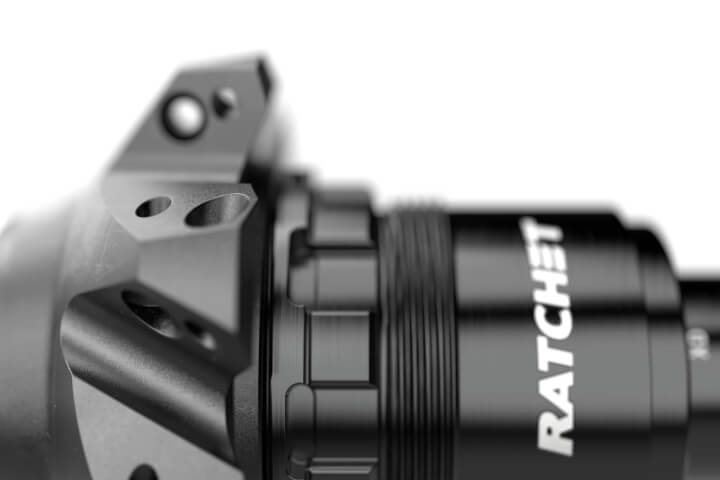
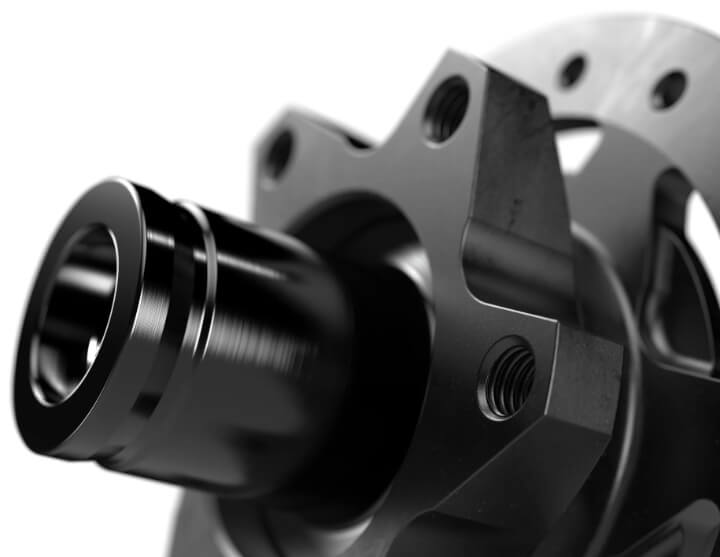
![]() Photo by dtswiss.com
Photo by dtswiss.com
Specifications:
- Weight: 275g
- Engagement Gap: 10 degrees
- Spoke Holes: 25 or 32 holes
DT-Swiss 180 v 240 v 350 Hub Comparison
Budget Pick
Industry Nine Hydra Hub Review
- Extraordinarily quick engagement.
- Durable design with improved bearing life.
- Customizable options (colors, configurations).
- Quieter than previous models.
- Made in the USA.
- Not as quiet as some competitors.
- High price point.
- May require adjustment to riding style.
- Limited compatibility with some bikes.
- Complex technology may intimidate some users.
![]() Photo by timlikesbikes
Photo by timlikesbikes
- Quality4.5/5
- Durability4.5/5
- Weight4/5
- Price3/5
- Overall4/5
The Industry Nine Hydra hub is a super popular product for mountain bikers. Known for its revolutionary design and performance. Made from 7075-T6 aluminum, these hubs are crafted in Industry Nine’s Asheville, NC facility, providing a high-standard, American product known for quality and precision.
A range of options are offered, including different axle fit, spoke hole drillings, disc rotor mounting, freehub bodies, and colors, catering to various rider preferences and requirements.
One of the Hydra’s most notable features is its impressive 690 points of engagement, resulting in a minuscule 0.52° of rotation required for engagement. This system, developed over two years of research and testing, provides almost instant power transfer from the pedal to the wheel, a significant advantage for riders navigating technical trails or requiring rapid acceleration.
Compared to its predecessor, the Torch hub, the Hydra has undergone several enhancements. It boasts bigger bearings, better seals, and a redesigned axle that reduces stress on the bearings, thereby improving durability. The sound of the Hydra hub is also a point of interest; it produces a higher-pitched and quieter buzz than the Torch, which some riders find more pleasant.
Regarding reliability, the Hydra’s design aims to improve bearing life. Its phased engagement system ensures that the load is evenly distributed across the pawls and driving, minimizing the stress and wear on the bearings. This design is particularly beneficial for riders who exert a lot of power or ride in demanding conditions.
The Industry Nine Hydra hubs are available in configurations and 11 anodized colors, accommodating nearly every hub width and axle standard. They also offer options for center lock or 6-bolt disc configurations and are compatible with single-speed and geared transmissions.
What does the I9 Hydra Sound Like?
Audio by NOBLWheels
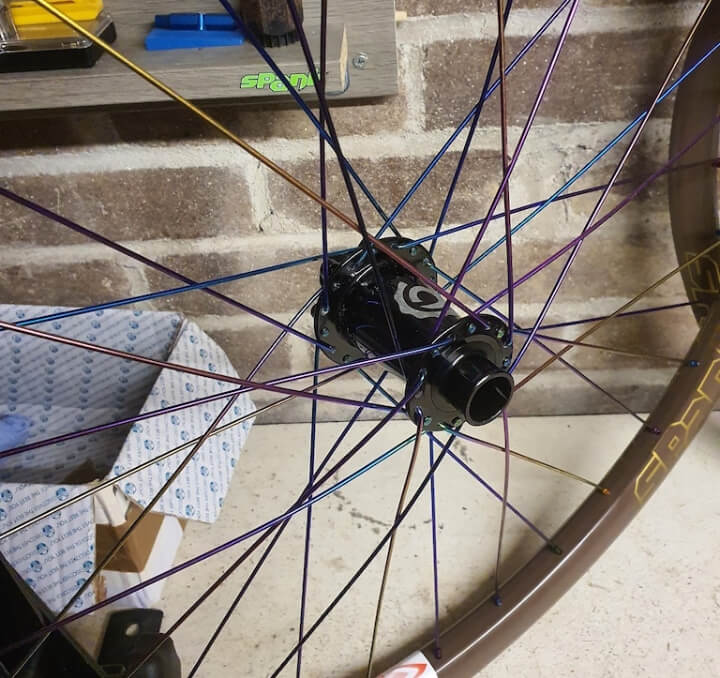
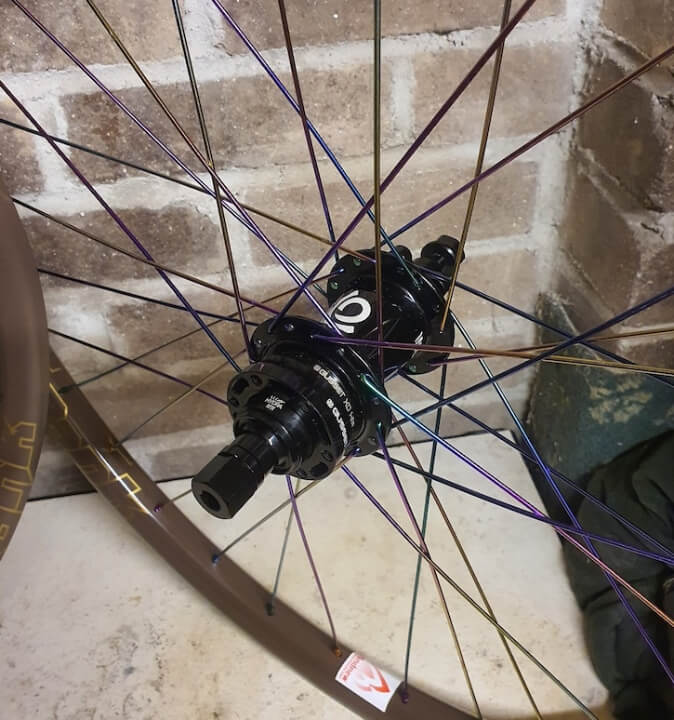
![]() Photo by @slopestyleworldwide
Photo by @slopestyleworldwide
Specifications:
- Engagements: 690 points
- Engagement Distance: 0.53 degrees
- Weight: 286g
- Spoke Holes: 28 or 32 holes
Industry Nine – Official Hydra Service Video
Best Hub Sound
Hope Pro 4 Boost
- Durable and reliable performance.
- Lightweight design (around 311 grams).
- Good value for the price.
- Wide range of colors and configurations.
- Compatible with various speeds (10, 11, 12).
- Louder than some other hubs.
- Engagement speed not as fast as some high-end models.
- Limited to specific frame sizes (148 x 12mm).
- May require additional maintenance for noise reduction.
- Not the lightest hub available on the market.
![]() Photo by noplacelikeloam
Photo by noplacelikeloam
- Quality4.5/5
- Durability4.5/5
- Weight4/5
- Price4/5
- Overall4.3/5
The Hope Pro 4 Boost hub is renowned for its reliability and quality build, making it a popular choice for wheel upgrades. This hub is compatible with 10, 11, and 12-speed setups, featuring a 4-pawl ratchet system with 44 tooth engagement (8.2 degrees). The hub shell is crafted from a single forged aluminum billet, ensuring strength and durability. It also boasts sealed stainless steel cartridge bearings for sustained performance under various riding conditions.
The Pro 4 Boost hub is specifically designed for 148 x 12mm frames, enhancing the stiffness of the complete wheel. It is available in several colors, including black, silver, red, blue, purple, and orange, and comes in 28, 32, and 36-hole drillings. These features make it versatile for different bike setups and personal preferences. The hub weighs approximately 311 grams, making it a lightweight option without sacrificing strength.
Users have praised the Hope Pro 4 Boost hub for its excellent value, offering quality comparable to higher-priced hubs at a more affordable cost. It is about 20 to 30 percent cheaper than other high-end options while providing top-notch fit and finish. The hub is appreciated for its lightweight design, contributing to easier acceleration and a more responsive ride. This can be especially beneficial for technical climbing and long rides on challenging terrains.
The sound of Hope hubs, but specifically the Pro 4 is notably loud, which some riders find appealing as it serves as a natural alert for hikers and other trail users. However, for those who prefer a quieter ride, the noise can be temporarily reduced by adding more freehub oil.
What does the Hope pro 4 MTB hub sound like?
Specifications:
- Pawls: 4
- Engagement Teeth: 44
- Engagement Distance: 8.2 degrees
- Spoke Holes: 28, 32, 36
- Weight: 311g
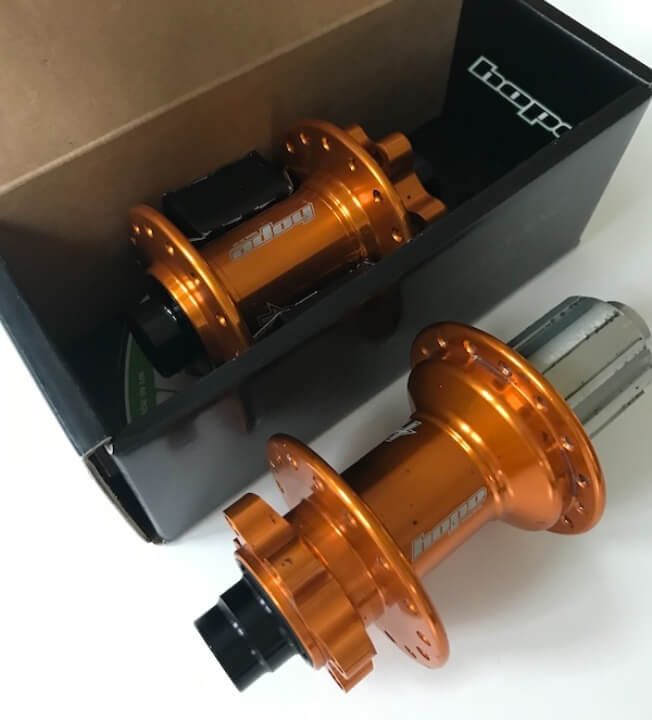
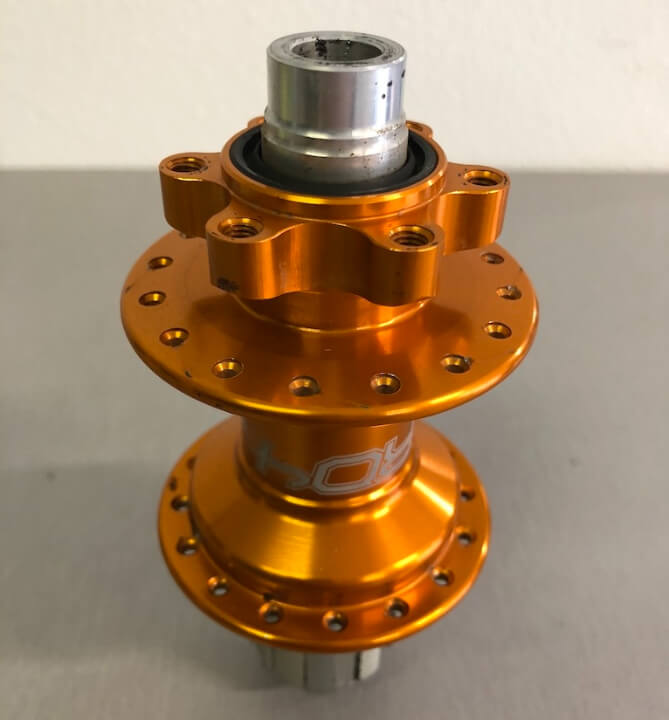
![]() Photo by noplacelikeloam
Photo by noplacelikeloam
Best Colors
Hope Pro 5 Hub
- The hub’s noise might be too loud for some riders.
- Price might be higher compared to some alternatives.
- The quick engagement may require an adjustment period for some riders.
- Complexity of design might intimidate non-technical users.
- The variety of options could be overwhelming for new buyers.
- Fast engagement with 108 points.
- Reduced drag and improved reliability.
- Stiffer hub shell and larger bearings.
- Versatile with various standards and color options.
- Proven durability and serviceability.
![]() Photo by chainreactioncycles.com
Photo by chainreactioncycles.com
- Quality4.5/5
- Durability4.5/5
- Weight4/5
- Price4/5
- Overall4.3/5
The Hope Pro 5 hub, building on Hope Technology’s 30-plus years of experience, represents a significant upgrade from the already successful Pro 4. This latest evolution focuses on enhancing reliability, reducing drag, and improving overall performance.
Key advancements include a new seal design and a re-engineered ratchet and pawl system. These changes reduce drag in the drive mechanism and increase the hub’s durability and reliability. The Pro 5’s zero-drag labyrinth seal is a notable feature, ensuring smooth freewheeling performance.
The Pro 5 hub boosts engagement from 44 to 108 points, using an offset six-pawl design on a 54-tooth ratchet ring. This design means that the freehub engagement angle has decreased from 8.2 to 3.3 degrees, offering much quicker pickup and a responsive feel when pedaling. There’s also an e-bike specific version that engages all six pawls simultaneously for higher durability.
Further enhancements include a stiffer hub shell and bigger bearings, achieved by a new axle design. This modification allows for a bearing with the same outer diameter but a smaller inner diameter, contributing to a longer bearing life and less maintenance. The hub is versatile, accommodating various freehub, disc, spoke, and axle standards, with interchangeable end caps to fit different axle widths.
After extensive testing, riders have noted the Pro 5’s rapid engagement, fast-rolling, and distinctive Hope buzz. Despite its loud sound, which may not suit all riders, the hub’s performance in challenging conditions has been praised. The bearings remained clean and smooth even after prolonged use without extra maintenance, attesting to the effectiveness of the labyrinth seals in keeping out dirt and moisture.
In terms of availability and support, Hope commits to producing spare parts for ten years after a product is discontinued, ensuring the long-term serviceability of the Pro 5 hub.
Specifications:
- Engagement Points: 108
- Ratchet Ring: 54t
- Engagement Distance: 3.3 degrees
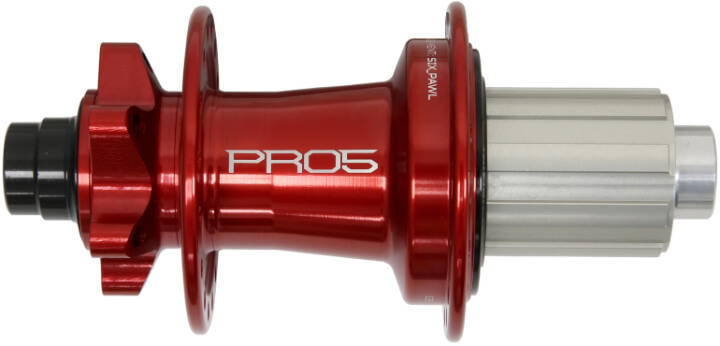
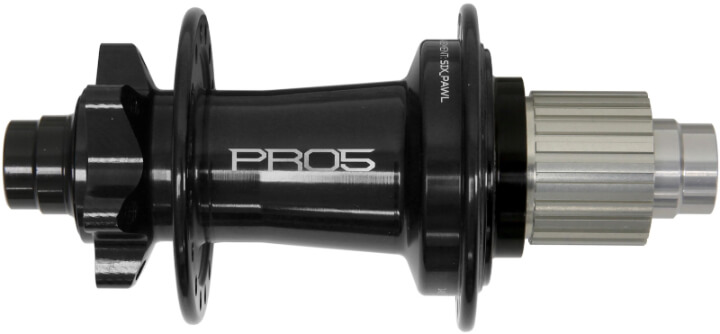
![]() Photo by chainreactioncycles.com
Photo by chainreactioncycles.com
The Hope Pro 5 Hub
Upgrade Pick
Onyx Vesper Mountain Bike Hub
- Lightweight design.
- Instant, silent engagement.
- Upgradeable bearings.
- Excellent customer support and warranty.
- Durable and easy to service.
- ‘Spongy’ engagement feel.
- May be less suitable for heavy riders.
- Requires precise installation.
- Potentially less robust for E-Bikes/Downhill.
- Higher cost with bearing upgrades.
![]() Photo by jukka4130
Photo by jukka4130
- Quality4/5
- Durability3/5
- Weight4/5
- Price3/5
- Overall3.5/5
The Onyx Vesper bike hub, a highly anticipated product from Onyx Racing Products, exemplifies the blend of innovation and performance in modern cycling technology. Known for their signature sprag clutch system, Onyx has managed to create a lighter and more adaptable version of their renowned hubs with the Vesper model, shedding approximately 156g in weight, depending on the configuration.
Key to the Vesper’s appeal is its instant engagement feature paired with silent, drag-free coasting, a hallmark of Onyx hubs. This revamped sprag configuration is lighter and uses less material without sacrificing performance. However, those with E-Bikes or Downhill bikes might still prefer the original Onyx hub, as it’s better suited for the heavy loads these bikes entail.
In terms of construction, the Vesper comes standard with stainless steel bearings, though there is an option to upgrade to Verinent hybrid ceramic bearings for an additional cost. This upgrade enhances the hub’s durability and performance. The dual-lipped seals on the exterior of the bearings ensure protection from elements, maintaining the hub’s longevity and ease of serviceability.
Weighing in at 16.3 oz / 462 g, the Vesper is relatively lightweight for its class, contributing to its appeal among performance-oriented cyclists. The hub also offers customization options in terms of bearing types, catering to different preferences and requirements.
Users have praised the Vesper for its silent operation and high engagement, a significant advantage for those who prefer a quieter ride without compromising on performance. This silent operation is achieved through the unique Sprag clutch system. However, it’s essential to ensure proper installation, as the cassette needs to be properly tightened and thread locked to prevent loosening during rides. The hub’s quality and fit are highly regarded, and Onyx’s customer support and a 10-year warranty add to the product’s value.
Despite these positives, some users have reported a ‘spongy’ feeling during engagement, which might be off-putting for some riders. This sensation is due to the sprag clutch system’s operation, which, while providing instant engagement, also has a unique feel compared to traditional ratchet systems. Some users find this sensation smooth and preferable, while others might take time to adjust to it. Additionally, there have been reports of the Vesper hub failing, particularly under heavy loads or with heavier riders, although warranty support seems to be robust.
Specifications:
- Hub Spacing: Standard
- Axle Width: 135mm
- Axle Diameter: 10mm
- Attach Style: Bolt-on
- Hub Shell Style: Solid
- Hub Shell Flange Type: Hook
- Bolts: Titanium
- Disc Brake Rotor Mount: Shimano Center Lock
- Driver Style: Shimano Hyperglide
- Spoke Tension: 120 (max kgf)
- Weight: 462g
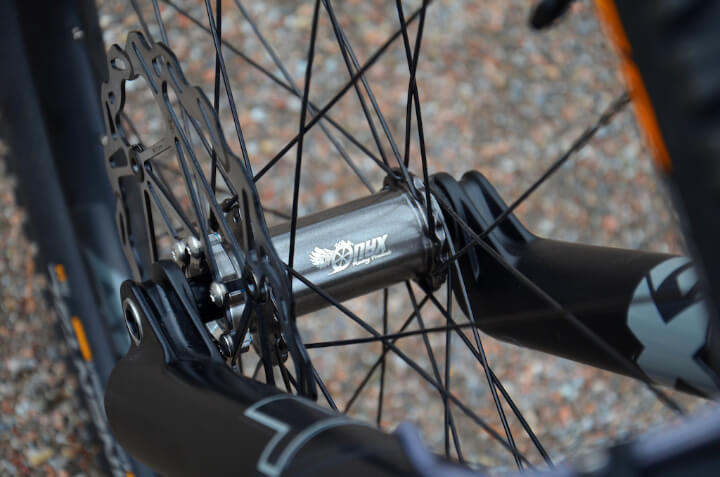
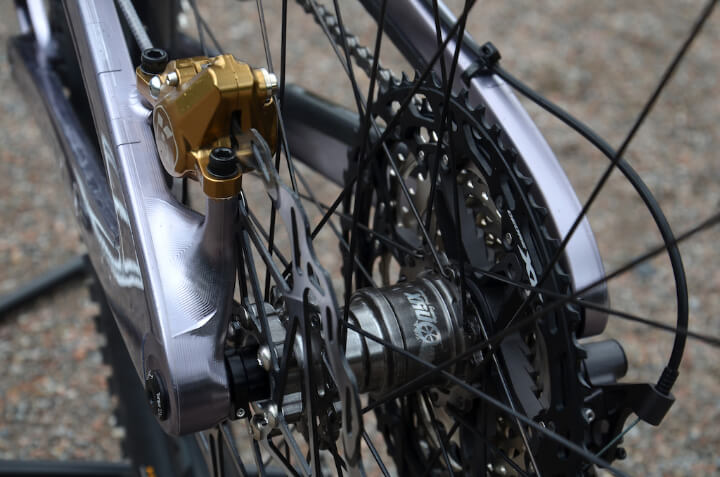
![]() Photo by jukka4130
Photo by jukka4130
Onyx Vesper – Silent, Instant Engagement MTB Hubs
Types of Mountain Bike Hubs
Freewheel Hubs
Freewheel hubs are a classic design in which the freewheel mechanism (the component that allows the wheel to spin freely while coasting) is a separate piece that screws onto the hub. This type of hub is commonly found on older or entry-level mountain bikes. Freewheel hubs are known for their simplicity and ease of replacement, as the entire freewheel can be unscrewed and replaced. However, they tend to be less durable under high torque conditions, such as those encountered in mountain biking.
Cassette Hubs
Cassette hubs are now the standard in modern mountain biking. Unlike freewheel hubs, the cassette hub has the freewheel mechanism built into the hub itself, and the gears (cassette) slide onto the hub and are held in place with a lockring. This design allows for a wider range of gears and a more efficient transfer of power from the rider to the wheels. Cassette hubs can handle higher torque loads and are generally more durable and reliable than freewheel hubs, making them a preferred choice for most mountain biking applications.
Direct-Engagement Hubs
Direct-engagement hubs, a relatively newer innovation in mountain biking, are designed for instant power transfer and minimal lag in engagement. These hubs have a mechanism that allows for almost immediate engagement of the drive system when the rider starts pedaling. This results in less lost motion and a more responsive ride, which is particularly beneficial in technical mountain biking where quick bursts of power are needed. Direct-engagement hubs are favored by riders who require precise control and immediate response from their bike.
MTB Hub Materials and Construction
Aluminum
Aluminum is a widely used material for MTB hubs due to its excellent balance of strength, weight, and cost. It is lighter than steel, making it a popular choice for riders looking to reduce the overall weight of their bike. Aluminum hubs are strong enough for most mountain biking demands and come in various designs and colors, offering both performance and aesthetic appeal.
Steel
Steel is known for its exceptional durability and strength, making it a suitable material for MTB hubs in high-stress situations. It’s often used in hubs designed for extreme riding conditions or for heavier riders. Steel hubs are typically heavier than aluminum, but their resilience in tough terrains is unmatched. They are a great option for those who prioritize longevity and robustness.
Carbon Fibre
Carbon fibre is a high-end material used in some premium MTB hubs. It’s incredibly lightweight and stiff, offering superior performance benefits. Carbon fibre hubs are often chosen by competitive riders and those seeking the best in technology and weight savings. However, they come at a higher cost compared to aluminum and steel hubs. Carbon fibre’s rigidity and lightness translate into faster acceleration and a higher degree of responsiveness, making them ideal for performance-oriented riders.
Types of Hub Bearings
Sealed Bearings
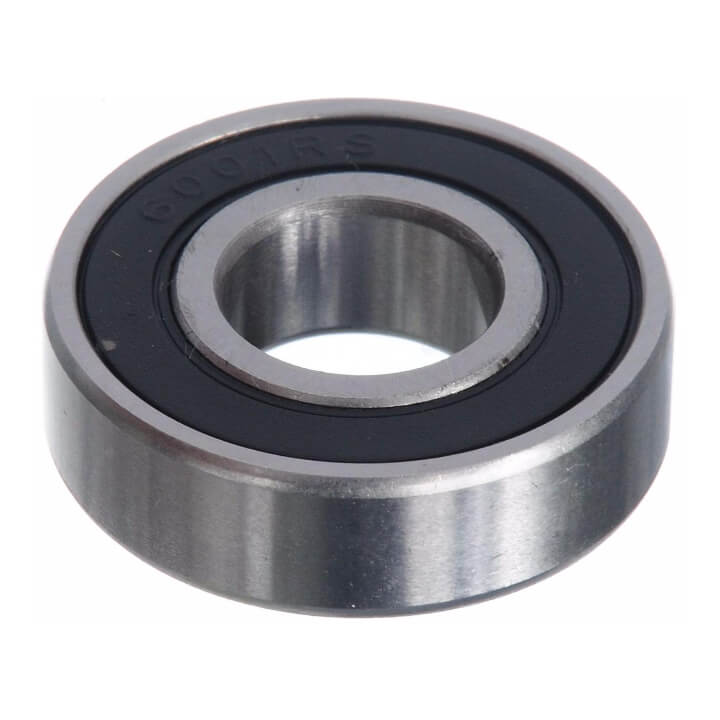
![]() Photo by chainreactioncycles.com
Photo by chainreactioncycles.com
Sealed bearings are the most common type found in modern bike hubs. They are known for their low maintenance and durability. Encased within a sealed unit, these bearings are protected from dirt and moisture, making them less susceptible to wear from external elements. They provide a smooth, consistent performance and are relatively easy to replace when worn out. Ideal for riders who prefer a hassle-free, low-maintenance setup.
Ceramic Bearings
Ceramic bearings represent a step up in terms of performance and efficiency. They are lighter and harder than steel bearings, which reduces friction and increases speed. These bearings are also more resistant to wear and less affected by heat, ensuring a longer lifespan. However, they come at a higher cost. Ceramic bearings are favored by performance-focused cyclists who seek every advantage in efficiency and longevity.
Cup and Cone Bearings
Cup and cone bearings are a traditional design found in many older and some high-end hubs. They consist of loose ball bearings placed between a ‘cup’ in the hub and a ‘cone’ in the axle. One of their main advantages is the ability to be serviced and adjusted for smoothness and play. While they require more maintenance and precise adjustment, they offer a level of customizability and repairability that sealed bearings do not. Ideal for enthusiasts who enjoy hands-on maintenance and fine-tuning of their bike components.
Types of Axles
Quick-Release

![]() Photo by chainreactioncycles.comQuick-release axles are a popular and traditional choice for many bicycles. They consist of a skewer that passes through the hollow axle, clamped in place by a lever-operated cam mechanism. The key advantage of quick-release axles is the convenience they offer; they allow for fast, tool-free removal and installation of wheels, making them ideal for situations where wheel removal is frequent, such as for transportation or tire changes. However, they can be less rigid than thru-axles, which might affect stability, especially in high-performance or off-road situations.
Photo by chainreactioncycles.comQuick-release axles are a popular and traditional choice for many bicycles. They consist of a skewer that passes through the hollow axle, clamped in place by a lever-operated cam mechanism. The key advantage of quick-release axles is the convenience they offer; they allow for fast, tool-free removal and installation of wheels, making them ideal for situations where wheel removal is frequent, such as for transportation or tire changes. However, they can be less rigid than thru-axles, which might affect stability, especially in high-performance or off-road situations.
Thru-Axles
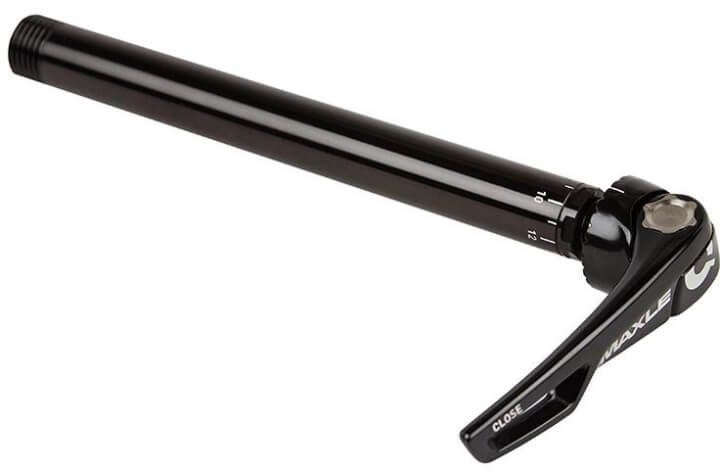
![]() Photo by chainreactioncycles.comThru-axles are increasingly common, especially in mountain bikes and newer road bike designs. They are a single, solid rod that slides through the hub and attaches directly to the bike’s frame or fork. This design provides a stiffer and more stable wheel-to-frame connection, enhancing handling and performance, particularly in rough terrain or at high speeds. Thru-axles also improve the alignment of disc brake rotors, reducing the likelihood of brake rub. They require a tool for removal, which can be less convenient than quick-release axles but offers a significant increase in performance and safety.
Photo by chainreactioncycles.comThru-axles are increasingly common, especially in mountain bikes and newer road bike designs. They are a single, solid rod that slides through the hub and attaches directly to the bike’s frame or fork. This design provides a stiffer and more stable wheel-to-frame connection, enhancing handling and performance, particularly in rough terrain or at high speeds. Thru-axles also improve the alignment of disc brake rotors, reducing the likelihood of brake rub. They require a tool for removal, which can be less convenient than quick-release axles but offers a significant increase in performance and safety.
What to Look For in an MTB Hub?
Hub Engagement Speed
The engagement speed of a hub is crucial, especially in mountain biking. A faster hub engagement results in a quicker response to pedaling. This is particularly beneficial in technical terrains where quick starts and stops are frequent. It enhances the bike’s efficiency and performance.
Bearing Quality
Bearings are the heart of a hub’s smooth operation. High-quality bearings, like sealed cartridge bearings, offer better durability and protection against elements. They ensure a smoother ride and prolong the hub’s lifespan.
Hub Durability
Durability is key in mountain biking. Hubs made from robust materials like aluminum or steel can withstand harsh conditions and impacts. A well-constructed hub not only lasts longer but also maintains performance under various riding conditions.
Bike Compatibility
Compatibility with your bike is essential. This includes making sure the hub fits the frame and fork dimensions, as well as being compatible with your bike’s brake system, whether it’s a disc or rim brake.
Weight Considerations
The weight of the hub can influence the bike’s overall weight and handling. While a lighter hub can be beneficial for agility and speed, it shouldn’t compromise the hub’s strength and durability. The choice often comes down to personal preference and riding style.
Sound Quality
The sound a hub makes is a personal preference. Some riders prefer a quieter hub, while others enjoy the audible feedback of a louder hub. The sound often correlates with the number of engagement points a hub has.
Brand Reputation and Warranty
Opt for hubs from reputable brands that are known for their quality. A good warranty is also a sign of the manufacturer’s confidence in their product, offering peace of mind and assurance of quality.
Best MTB Hub Brands
DT Swiss

DT Swiss is renowned in the cycling world for its precision engineering and high-quality components. Originating from Switzerland, a country known for fine craftsmanship, DT Swiss hubs are synonymous with reliability and performance.
One of their standout features is the star ratchet system, unique to DT Swiss, which provides quick and reliable hub engagement. This system is both user-serviceable and customizable, allowing riders to adjust the level of engagement to their preference.
Additionally, DT Swiss hubs are known for their lightweight design, which doesn’t compromise on strength or durability. This combination of lightweight construction, robust performance, and ease of maintenance makes DT Swiss a top choice for mountain bikers at all levels.
Hope

Hope is a British company that has built a reputation for producing some of the most durable and visually striking bike components on the market.
Specializing in CNC-machined parts, Hope hubs are known for their high precision and quality. What sets Hope apart is their attention to detail and commitment to in-house manufacturing, which ensures a high level of quality control.
Their MTB hubs are particularly popular for their robust construction and the distinctive sound of their freehub, which is favored by many riders. Hope hubs offer excellent sealing against the elements, making them ideal for the muddy and wet conditions often encountered in mountain biking. They also come in a variety of colors, allowing riders to customize the look of their bikes.
The combination of durability, performance, and aesthetic appeal makes Hope an excellent choice for mountain bikers who demand the best in both function and style.
Frequently Asked Questions
How does hub engagement speed affect performance?
The speed of hub engagement can impact a bike’s performance, especially in mountain biking. Faster engagement means a quicker response when pedaling, offering better acceleration and efficiency in technical terrains where frequent stopping and starting occurs. However, it may have less impact in situations where constant pedaling is maintained.
Do premium hubs significantly upgrade ride quality?
Premium hubs can enhance ride quality. They often feature better bearings and construction materials, leading to smoother rides and improved durability. The precision in these hubs can also contribute to better power transfer and reduced friction, further enhancing the riding experience.
Which MTB hubs are best for sound quality?
The sound quality of MTB hubs is subjective and varies based on personal preference. Hubs with more engagement points tend to produce a louder, more frequent clicking sound, which some riders prefer. Brands like Chris King, Hope, and Industry Nine are known for their distinctive sounds and are often chosen by riders who prioritize auditory feedback from their hubs.


